
acein
-
Posts
29 -
Joined
-
Last visited
Content Type
Profiles
Forums
Articles
Gallery
Downloads
Events
Posts posted by acein
-
-
I do not currently have a furnace. I am still coming up with a plan to dial these dies in. I don't like the idea of farming it out. I enjoy trying to figure out the problem.
Thank you for the response!
-
Thanks for the input Goods. Although I asked for a consensus of how hard people recommend power hammer dies I got no specific response. I started a new thread hoping I could focus on the question at hand so I will keep my response in line with that.
4340 only gets to 60 HRC max, if I were able to process it in some very advanced ways. So If I heat treat it at home I will only be able to get it into the range of 45-50 HRC Which from some research I have done online is the right hardness for dies. That is what I mean when I say I want it at the upper end of it's hardenability.
is your concern that the 50 HRC would make the 4340 too brittle, or that the 50 HRC is too hard?
-
I have been working on getting help heat treating a set of power hammer dies I have made. The Dies are roughly 2x3x4 (one is slightly larger). I did some research online and read the posts in heat treating. The following is the process I have come up with that I hope will yield the best results. If there is anything that you more experienced heat treaters see that might pose an issue please let me know.
Step 1. Normalize the material to relieve stress.
Heat dies to 1000-1022 degrees F for 2 hr. Furnace cool to 850 degrees F at 50 degree drop per hour. Then remove and place in vermiculite. Allow to cool completely.
Step 2.
Heat dies to slowly to 1550 F, hold until uniform. Quench in oil (I will be using warm vegetable oil) to 200 f.
Step 3.
While still warm (200f), reheat to 850-1200f. Hold for 2 hours then air cool.
The biggest question I have at this point is what temp. is best for tempering. I want this material to be on the upper end of it's hardenability. It seems to me I would want to temper at the lower end of the spectrum. Is this correct.
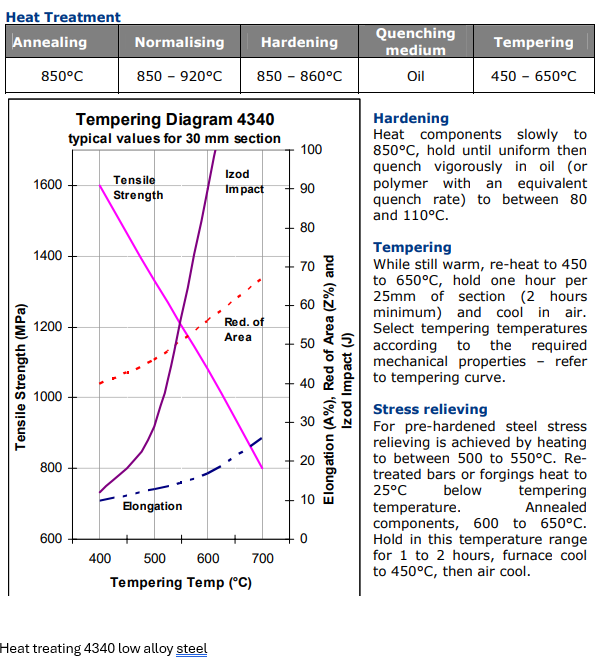
-
Thank you Steve for your 2 cents
Billy, Thank you.
Nobody Special, when you say particularly thick dies would you consider 2x3x5 thick? -
Duly noted. Sarcasm in response to Snide remark, bad. Calling into question someone’s intelligence because of sarcasm, perfectly acceptable. Threatening to ban someone because Steve doesn’t like sarcasm, good
Moving on…
The topic at hand is heat treating 4340. To answer Billy’s question I will not be forging it. I picked up a rem of the right size for power hammer dies. I had read that 4340 can be a good choice for that. However there is some question about whether 4340 can be hardened to where it should be for dies.
From what I can tell 50Hrc would be acceptable for dies. This would mean I have to get the material to almost maximum hardness for 4340.
I am looking for the best process to do this.
Thank you for any help.
-
You didn’t hurt my feelings. I’m frustrated by your posts. This is how a conversation seems to go on iforgeiron.
Me:
How do I get from here to their?
Reply1:
I went there once:
Reply2:
You used the wrong spelling for There!
Me:
Thanks you are right. It should be There.
Wait three days…
Me:
So back to my original thought. How do I get from here to there?
Steve:
Its been posted here before.
Me:
Thanks I have been trying to search this cryptic forum to no avail. Haha the instructions to use google search for your topic and iforge yielded no usable results. By the way the info you provided doesn’t answer my question.
Me:
How do I get from here to there?
Steve and frosty, you don’t have to reply to every post. Especially when you have nothing helpful to say.
-
Thanks for the reply Swedefiddle. Yes I can't rename the topic. 4340 is a heat treatable low alloy steal containing Nickel, Chromium, and Molybdenum. The steel is supposed to have great fatigue strength over time. It is also supposed to max out around 60 HRC.
I miss quoted earlier when I said Flame hardening. Being as that I don't know what xxx xxxx I am talking about and came here for help. What I should have stated (thanks Steve for being so helpful, yes that is sarcastic) is Flame hardening can get up to 50 and Nitriding can get you 60.
This is taken from Techsteel.net:
After tempering, flame or induction hardening will produce material with Rc 50, while nitriding will produce Rc 60.
-
Steve, are you really asking me to explain something I am asking about?
-
Patrick, thanks for the information. I have read online that I can harden 4340 up to 60HRC. Some say I can get 45 HRC with quenching, Then flame harden up to 60. Do you think this is achievable?
-
What are your recommendations on hardness of power hammer dies?
-
-
Thanks for the info!
-
I bought some 4340 today at a metal supplier. It was a perfect size remnant. Now I just need some help with the best process to make the dies. I am thinking of attempting to use make them myself using abrasive cut off wheels and a 2" belt grinder.
Would it be best to anneal the material them perform the grinding? or Grind the material as is knowing it will take a little more work?
I am not too keen on attempting the heat treat process because I don't have an oven or enough oil to quench. I could purchase everything if it is the best option. I just don't know if the application requires the 4340 to be completely heat treated.
-
When you purchase a tool steel such as 4340 what is the typical hardness off the shelf? I guess what I am asking is what state does the metal come out of the manufacturing process in? Is it allowed to cool slowly? Any thoughts or ideas?
-
Thanks for the responses.. I will let you know what I end up with. I will get some pics up too.
-
That's great! Are they flat dies or combo dies?
I don't have any milling capabilities other than what I can achieve by hand. Was hoping to find recommendations on plug and play dies or dies that I could modify slightly to fit.
-
I recently began rebuilding a boss power hammer made by novelty iron works. I am missing the bottom die that came with the hammer. I have been searching for specs on similar hammers such as the little giant to see if I might be able to use those dies interchangeably. It seems it would be more cost effective to purchase a replacement set from littlegianthammers.com or similar company that is in the habit of making and heat treating these dies on a regular basis rather than talking to a machine shop to custom make one set.
Any ideas on a shop who might be able to make them?
-
Thanks for the Plug!! We are gonna have a HooTaNannY! (its gonna be fun I tell ya)
No Problem! The fall conference in Chehalis was great, very informative. I just thought the fine folks on ifi might want to know. -
The Northwest Blacksmith Association is holding it's annual spring conference in Mount Vernon, WA. on April 22-25.
Any who might want to attend can visit WWW.blacksmith.org for more info. Some great events planned. See ya there. -
I have been looking for coal forges in my area, and today my wife spoke to an individual selling what he calls a popcorn forge. I've heard the term before but I don't know if there is any difference between that and a typical coal burning forge. From her description of it, it sounded like a regular coal burning forge. Does anybody know what the differences, if any are, or why he is calling it a popcorn forge.
-
I'll try to get some pics soon. The tongs aren't the prettiest things in the world, but they work great.
-
tonight I fired up my forge for the very first time, with information i got from iforgeriron. It worked great. I made my first pair of tongs. feels good thanks for all the great advice.:D
-
maybe you could give me some info on your classes I'm in the columbia river gorge i get into portland often
-
Eagle mountain, Huh, I know some folks down that way. Whats up Pops?
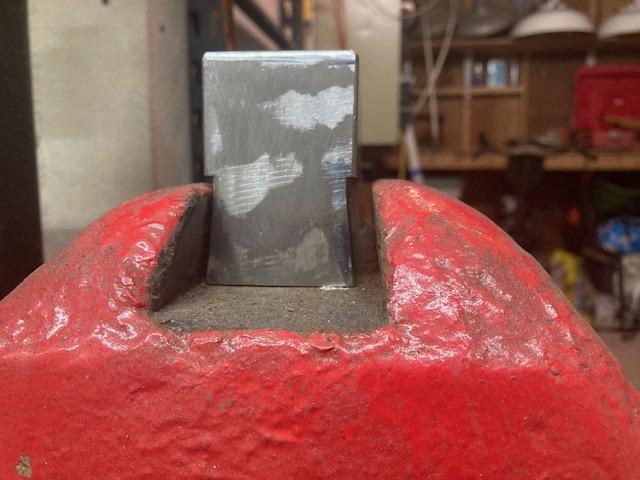
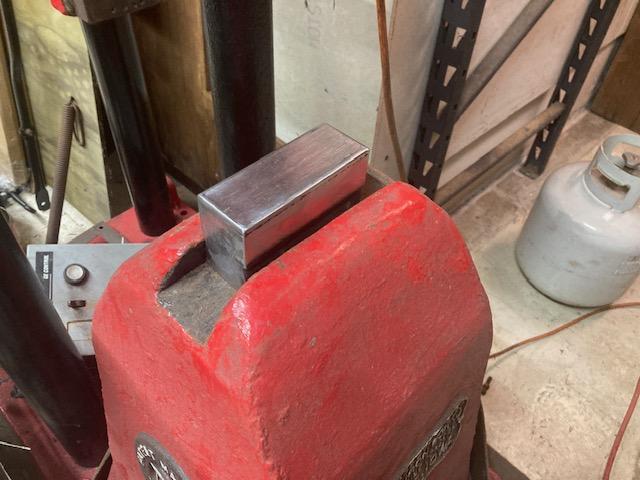
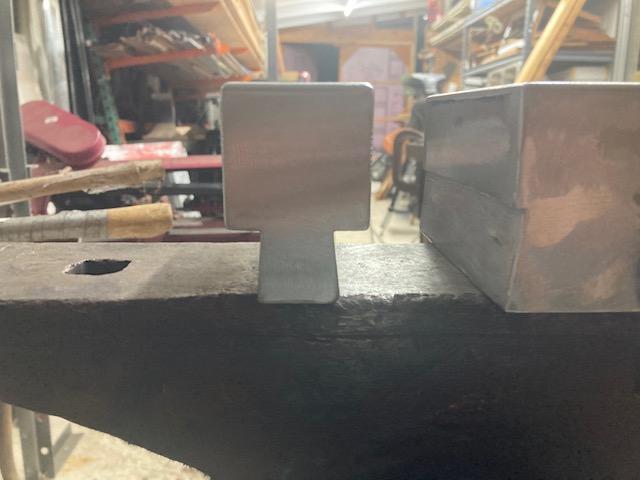
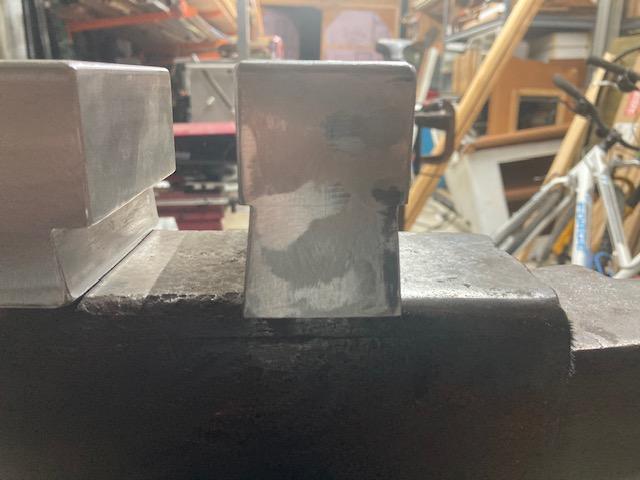
Heat Treating 4340 Power Hammer Dies
in Heat Treating, general discussion
Posted
Before I know if I have the right tools I need the right process. Which I am hoping someone can help me with here.
I am willing to learn from failure.